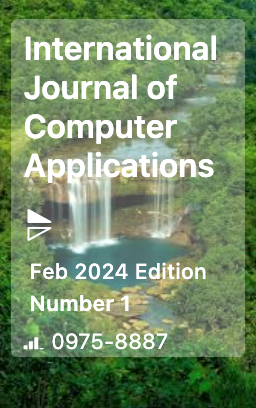Reseach Article
Integration of Real-Time Spatiotemporal Data to Improve the Accuracy of Machine Learning Models for Road Traffic Congestion Prediction
| Journal of Advanced Artificial Intelligence |
| Foundation of Computer Science (FCS), NY, USA |
| Volume 2 - Number 2 |
| Year of Publication: 2025 |
| Authors: Mohammad Alam, Mary Lind, Oludotun Oni |
 10.5120/jaai202447
10.5120/jaai202447
|
Mohammad Alam, Mary Lind, Oludotun Oni . Integration of Real-Time Spatiotemporal Data to Improve the Accuracy of Machine Learning Models for Road Traffic Congestion Prediction. Journal of Advanced Artificial Intelligence. 2, 2 ( Sep 2025), 18-25. DOI=10.5120/jaai202447
Abstract
Urban traffic congestion has emerged as one of the most pressing challenges in today's metropolitan areas, directly influencing economic productivity, environmental sustainability, and the overall quality of life for urban residents. With the continuous rise in vehicle numbers and the increasing complexity of transportation networks, the ability to detect and predict congestion with high accuracy has become critical for effective traffic management and planning. Although machine learning (ML) models have demonstrated considerable promise in traffic prediction tasks, their performance often lacks contextual depth when trained solely on temporal data, such as timestamps or aggregated historical traffic patterns. This study addresses this gap by investigating the integration of real-time spatiotemporal data, incorporating both spatial features (road location, number of lanes, geographic coordinates, and event information) and temporal features (time-of-day, day-of-week, etc.) to enhance the predictive accuracy of ML models for road traffic congestion. Using a comprehensive dataset collected from a metropolitan city, five different ML models were implemented and evaluated, including Support Vector Machine (SVM), Random Forest (RF), Convolutional Neural Network (CNN), Recurrent Neural Network (RNN), and a hybrid CNN-RNN architecture. Each model was trained and tested under two scenarios: temporal features only and integrated spatiotemporal features. The results indicate that spatiotemporal integration substantially improves prediction accuracy across most models, with ensemble-based methods such as RF achieving near-perfect classification, and hybrid deep learning architectures demonstrating significant gains compared to their temporal-only counterparts. Statistical significance testing further validated these improvements, reinforcing the value of spatiotemporal enrichment for predictive tasks. The findings underscore that spatial and temporal contextualization of traffic data improves model robustness and provides critical insights for developing intelligent transportation systems (ITS) capable of delivering real-time, adaptive congestion management solutions. This research contributes to the growing knowledge in smart mobility by offering empirical evidence that spatiotemporal data integration is a key driver of accuracy and reliability in ML-based traffic prediction.
References
- Texas A&M Transportation Institute. (2024). Urban Mobility Report 2023. Texas A&M Transportation Institute. https://tti.tamu.edu/2024/06/tti-publishes-2023-urban-mobility-report/.
- Zhou, Q., Chen, N., & Lin, S. (2022). FASTNN: A Deep Learning Approach for Traffic Flow Prediction Considering Spatiotemporal Features. Sensors, 22(18), 6921. https://doi.org/10.3390/s22186921.
- Wei, X., Ren, Y., Shen, L., & Shu, T. (2022). Exploring the spatiotemporal pattern of traffic congestion performance of large cities in China: A real-time data based investigation. Environmental Impact Assessment Review, 95, 106808.
- Gao, Y., Li, J., Xu, Z., Liu, Z., Zhao, X., & Chen, J. (2021). A novel image-based convolutional neural network approach for traffic congestion estimation. Expert Systems With Applications, 180, 115037. https://doi.org/10.1016/j.eswa.2021.115037.
- Christalin, N. S., Mandal, T. K., & Prakash, G. L. (2022). A Novel Optimized LSTM Network for Traffic Prediction in VANET. Journal of System and Management Sciences Vol. 12 No. 1, pp. 461-479. https://doi.org/10.33168/JSMS.2022.0130.
- Slimani, N., Amghar, M., & Sbiti., N. (2022). Deep learning and time series analysis on traffic flow forcasting. Journal of Theoretical and Applied Information Technology, 100(5). https://www.jatit.org/volumes/Vol100No5/5Vol100No5.pdf.
- Medina-Salgado, B., Sanchez-DelaCruz, E., Pozos-Parra, P., & Sierra, J. E. (2022). Urban traffic flow prediction techniques: A review. Sustainable Computing: Informatics and Systems, 35, 100739. https://doi.org/10.1016/j.suscom.2022.100739.
- Shang, Q., Tang, Y., & Yin, L. (2024). A hybrid model for missing traffic flow data imputation based on clustering and attention mechanism optimizing LSTM and AdaBoost. Scientific Reports, 14, Article 26473. https://doi.org/10.1038/s41598-024-77748-1.
- Li, M., Li, M., Liu, B., Liu, J., Liu, Z., & Luo, D. (2022). Spatio-Temporal Traffic Flow Prediction Based on Coordinated Attention. Sustainability, 14(12), 7394. https://doi.org/10.3390/su14127394.
- Zhao, Z., Tang, L., Fang, M., Yang, X., Li, C., & Li, Q. (2023). Toward urban traffic scenarios and more: A spatio-temporal analysis empowered low-rank tensor completion method for data imputation. International Journal of Geographical Information Science, 37(9), 1936–1969. https://doi.org/10.1080/13658816.2023.2234434.
- Tang, J., Zhu, R., Wu, F., He, X., Huang, J., Zhou, X., & Sun, Y. (2025). Deep spatio-temporal dependent convolutional LSTM network for traffic flow prediction. Scientific Reports, 15, Article 11743. https://doi.org/10.1038/s41598-025-95711-6.
- Javed, A. R., Maddikunta, P. K. R., Gadekallu, T. R., Khan, M. A., & Raza, M. (2023). A Survey of Explainable Artificial Intelligence for Smart Cities. Electronics, 12(4), 1020. https://doi.org/10.3390/electronics12041020.
- Jiang, D., Zhao, W., Wang, Y., & Wan, B. (2024). A spatiotemporal hierarchical analysis method for urban traffic congestion optimization based on calculation of road carrying capacity in spatial grids. ISPRS International Journal of Geo-Information, 13(2), 59. https://doi.org/10.3390/ijgi13020059.
Index Terms
Keywords

